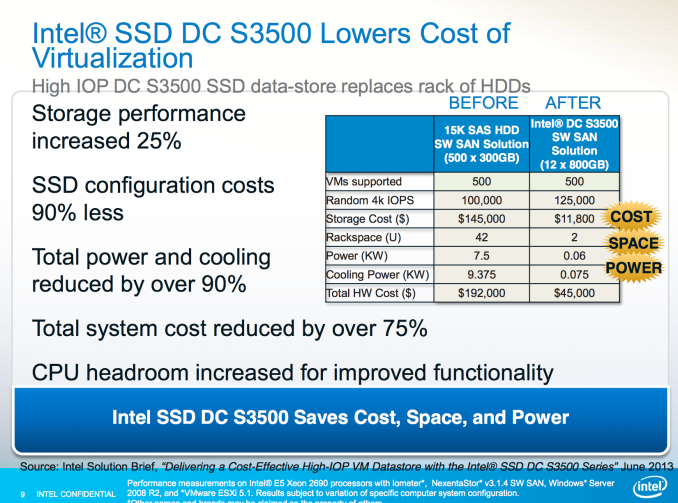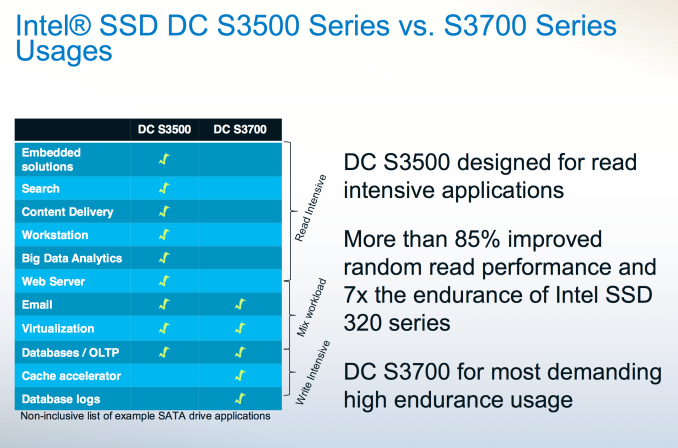Intel SSD DC S3500 Review (480GB): Part 1
by Anand Lal Shimpi on June 11, 2013 6:10 PM EST- Posted in
- Storage
- IT Computing
- SSDs
- Intel
- Datacenter
- Enterprise
Final Words
In our first high level look, Intel's SSD DC S3500 looks to be everything we loved about the S3700 but at a more affordable price point for enterprise customers who don't need insane amounts of write endurance. With SSDs in the enterprise there's this tendency to over estimate endurance needs. I was guilty of it in the design of our SSD requirements for serving AnandTech. Part of the problem is there aren't tons of good software applications to quietly monitor/report/analyze enterprise workload behavior. I suspect that for the vast majority of use cases however, the S3500 is likely more than enough. Even though the AnandTech database servers (content, stats tracking and forums) are fairly write intensive, the S3500 is actually the right target for us - the S3700 would deliver far more endurance than we'd ever use.
Other than write endurance, the only other thing you give up is random write performance. Intel's specs list the S3500 at roughly 1/3 of the sustained 4KB random write performance of the S3700, which I saw in our numbers as well. Given the lower price point however, most customers are likely comparing performance to an array of hard drives. On an individual level, a good high-end HDD will provide somewhere around 1 - 2MB/s in 4KB random write performance. The S3500 by comparison is good for about 40MB/s. Intel's own data shows that 12 S3500s will deliver roughly the same random IO as 500 15K RPM hard drives. Based on the data I've seen, that comparison is pretty accurate.
All of the other S3700 benefits remain. Performance consistency is excellent, which makes the S3500 ideal for use in many-drive RAID arrays. Intel's enterprise drives have typically done very well in terms of reliability as well (and I haven't heard any complaints about the S3700), making the S3500 a safe bet. My only real complaint about this drive is the idle power rating is too high for notebook use, because otherwise I'd even suggest looking at the S3500 for consumer use as well.
All in all I've been pleased with Intel's work in the enterprise SSD space. Most interesting to me is just how aggressive Intel has been in terms of enterprise SSD pricing. The S3500 shows up at well under $1.50/GB, and consumer drives aren't that far off in terms of pricing. Intel typically doesn't push this aggressively for lower prices with its enterprise products, so when it happens I'm very happy.












54 Comments
View All Comments
toyotabedzrock - Thursday, June 13, 2013 - link
If my math is correct, excluding the spare area, this mlc can only be written to 700 times?ShieTar - Friday, June 14, 2013 - link
Your math is unrealistically simplified. You could fill up 75% of the drive with data that you never change, so then you can write the remaining 25% of space 2800 times before you reach the 450TB written.Also, Intel only want to guarantee 450TB written. That could still mean that the average drive survives much longer, it just is not meant as a major selling point for this drive.
jhh - Friday, June 14, 2013 - link
I don't understand why the review says latency measurements are done, when the chart shows IOPS. Latency is measured in milliseconds, not IOPS. I want to know how long it takes for the drive to complete an operation after it gets the command. Even more interesting is how that measurement changes as the queue is bigger or smaller. Any chance of getting measurements like this?I'm not sure how this works in Windows, but in Linux, when an application wants to be sure data is persistently stored, this operation translates into a filesystem barrier, which does not return until the drive has written the data (or stored it in a place where it's safe from power failure). The faster the barrier completes, the faster the application runs. This is why I would like to know latency in milliseconds. While IOPS has its value, so does milliseconds.
mk8 - Tuesday, January 14, 2014 - link
Anand, I think one thing that you don't mention at all in the article is IF the S3500 needs or benefits of over provisioning. I guess the performance benefits would be minor, but what about write amplification? I look forward for the "Part 2" of the article. Thanks